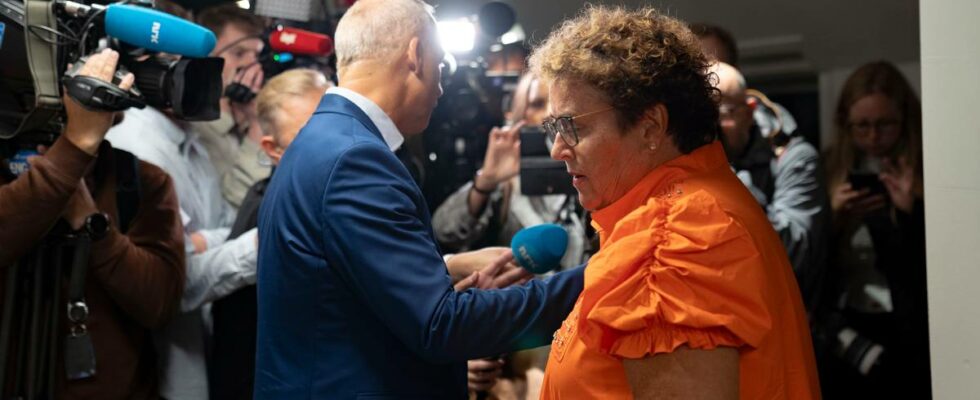They couldn’t stand there together. They were no longer a trio. The ice front seemed total. Only when Bollestad’s orange back had been led out of the room did the two remaining in the lead come to have their say. Olaug Bollestad resigned as party leader. It was her own choice, we learned. The choice was boringly repetitively respected by Dag Inge Ulstein and Ida Lindtveit Røse. Photo: Hanna Johre The central board meeting was over. For seven strange hours, emotions had trembled around the conference table. The temperature had been high. The atmosphere was serious from the start. It went as it had to, we often report in the press. Here it is only partly true. The most startling thing about the KrF drama has not been fully told, it is difficult to understand: The distrust was greater within the leadership trio than between the central board and its leader. Bollestad had to go because she lost the ability to lead with someone, not primarily because she lost her entire party. The situation is unbelievable! Significant cooperation problems What struck her were cooperation problems that had been covered up for a long time. A pressure cooker that finally exploded in early August. The entire central board received shocking testimony and ground-breaking insight into deep cooperation problems in the party’s day-to-day management on 6 August. The problems must have been attempted to be addressed and resolved over a long period of time, especially since the beginning of June. On Friday this week, there is therefore no possible solution. The central board must see a trio of leaders who are unable to lead together. Too late to do anything about it. Bollestad came to the meeting with the desire to find a solution. Several votes in the central board did the same. At the same time, it becomes clear that the main problem is defined as Bollestad’s leadership style. An unmentionable, but central notice becomes a kind of proof anyway. A solution would require both the will and the ability to reconcile. It was obviously not sufficiently present yesterday. Where the responsibility for that should be placed, only those involved know. It is impossible to judge whether Bollestad extended a hand or made unrealistic demands for overtime in a lengthy process. None of the parties, not even Bollestad, will come out of this very well. A party leader on sick leave feels helpless, defenseless and alone. The most central party leaders are afraid that external pressure, internal expectations and paralyzing flood-lit dishes will destroy the party completely over time. Therefore, there is no other way out than for Bollestad to resign. She was no longer the best party leader KrF could have. Bollestad, Ulstein, Røse and general secretary Ulfstein were unable to lead the party together. Even if you think it’s unfair or wrong, it becomes an unshakable fact throughout these seven hours. Røyse is the long-term choice Now KrF has been sent into a management vacuum and organizational uncertainty that it would be harmful if it lasted too long. Dag Inge Ulstein serves as manager until further notice. Ida Lindtvet Røse is a more long-term choice, writes political commentator Lars Nehru Sand. Photo: Hanna Johre / news Dag Inge Ulstein is acting leader (elected as first deputy leader), but seems adamant that he should neither lead the party longer than necessary nor seek re-election to the Storting. He then states unequivocally that he does not want, can’t bear or is interested in giving everything for KrF with his whole being. A more long-term choice would be to elect second deputy leader Ida Lindtveit Røse as party leader. Then Ulstein cannot work for the spring’s ordinary national meeting, well into an election year. There is only one number one and if Røse is to be that, she must be trusted as soon as possible. Whether she will be constituted by the national government or wait to be elected is still in the blue. KrF must have a plan for how this is to be resolved during the next week. It is urgent to give the party stability. She has not fully responded to Røyse’s view of the conflict with Bollestad. The party will certainly want to hear her version. She must be elected with full support and all confidence. If anyone thinks she has played a role in pushing Bollestad out, or did not want to reconcile with Bollestad, it will destroy her opportunity to quickly rally the party. Whether you think it was right or wrong that Bollestad left, you have to be able to applaud whoever comes. To put it mildly, Lindtveit is far from certain of a seat in the Storting from the next term, unless she is invited onto the list for Hordaland, Rogaland or Vest-Agder. In all three constituencies, it does not seem as if the door is high or the gate particularly wide. The bottle spout points to It is a very demanding and very thankless job to take over KrF. History is a bit too full of KrF leadership changes that have not been wanted or planned. Whether it is internal pressure and leadership style (Høibråten), strategic blunders (Hareide), self-inflicted scandal (Ropstad) that causes the leader to resign, all successors come about because “the bottle spout happens to point to” the successor. Even not in a family party, leaders can be chosen according to a parent-meeting principle. Røse would probably have inherited the party anyway in 2027. Now it can happen because she has to. Which cheerleader, which mandate will she get? While the leadership changes happen completely unplanned, support falls and the party’s project seems to be survival, as much as a clearly rooted political project. Does it hold? So far the party has survived to a greater extent than their leaders. That’s not a very impressive answer. Published 23.08.2024, at 15.58
ttn-69
Bollestad field of cooperation problems – Statement

